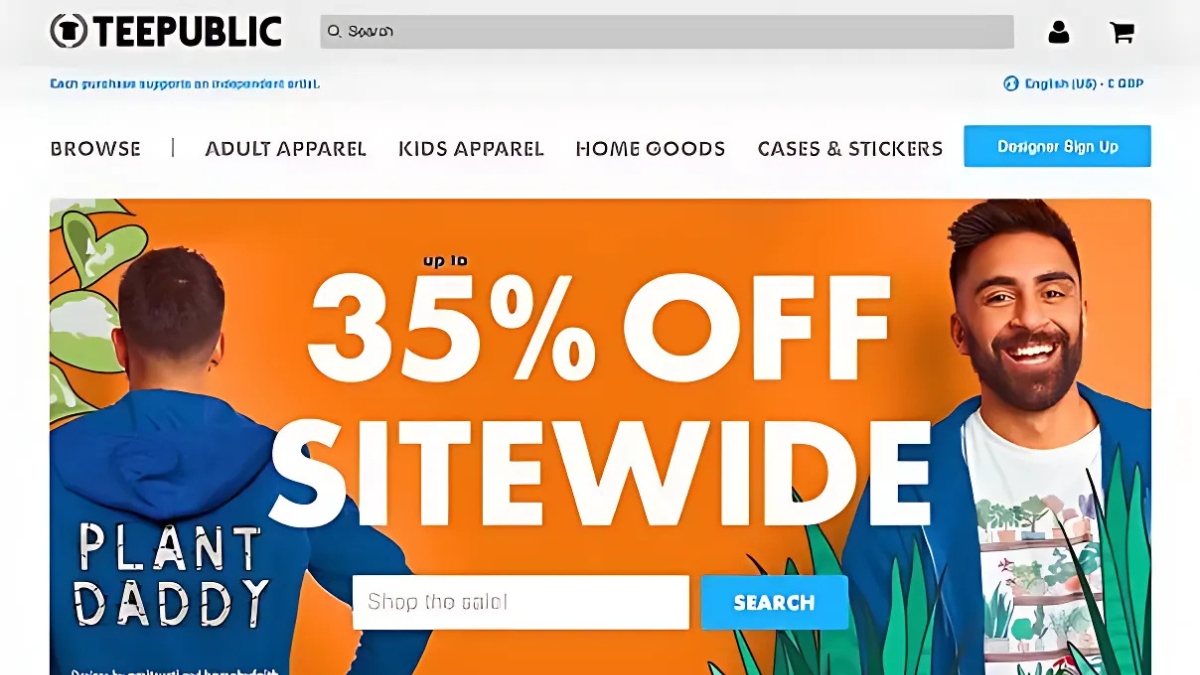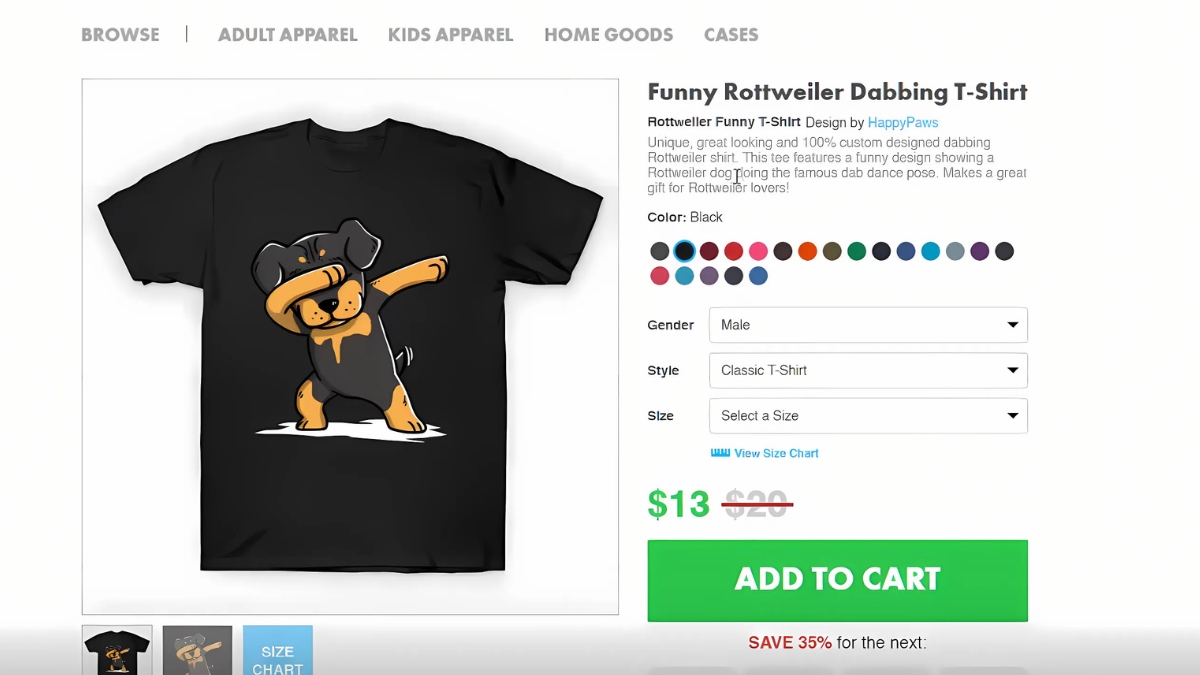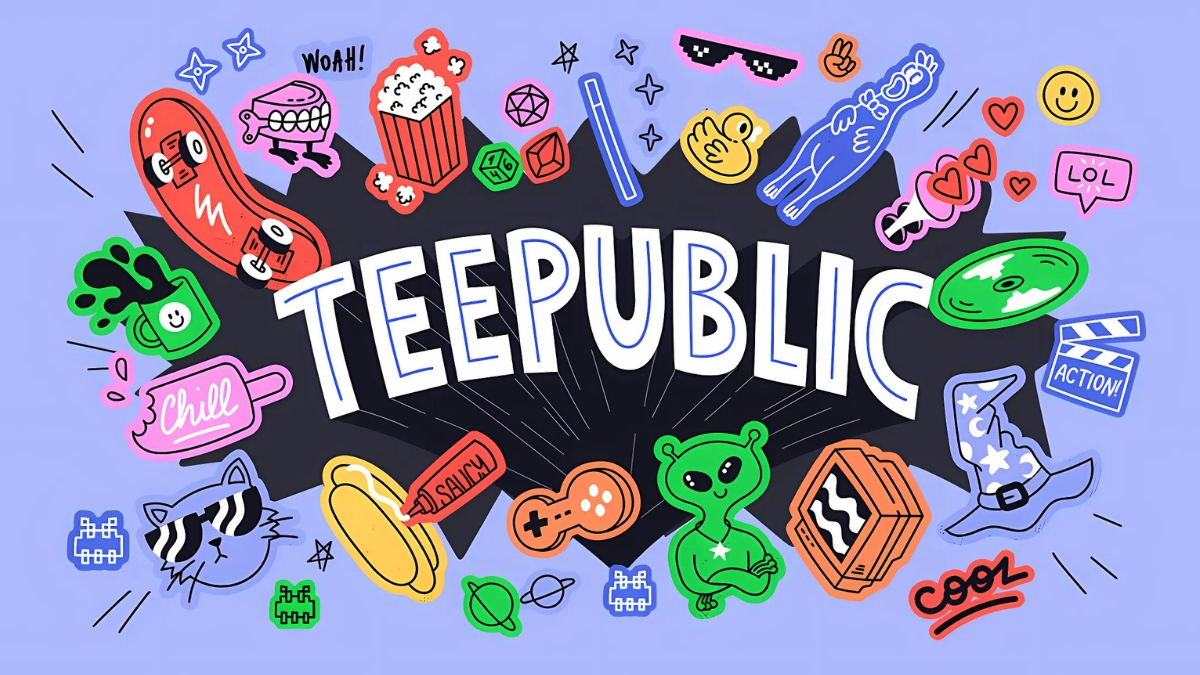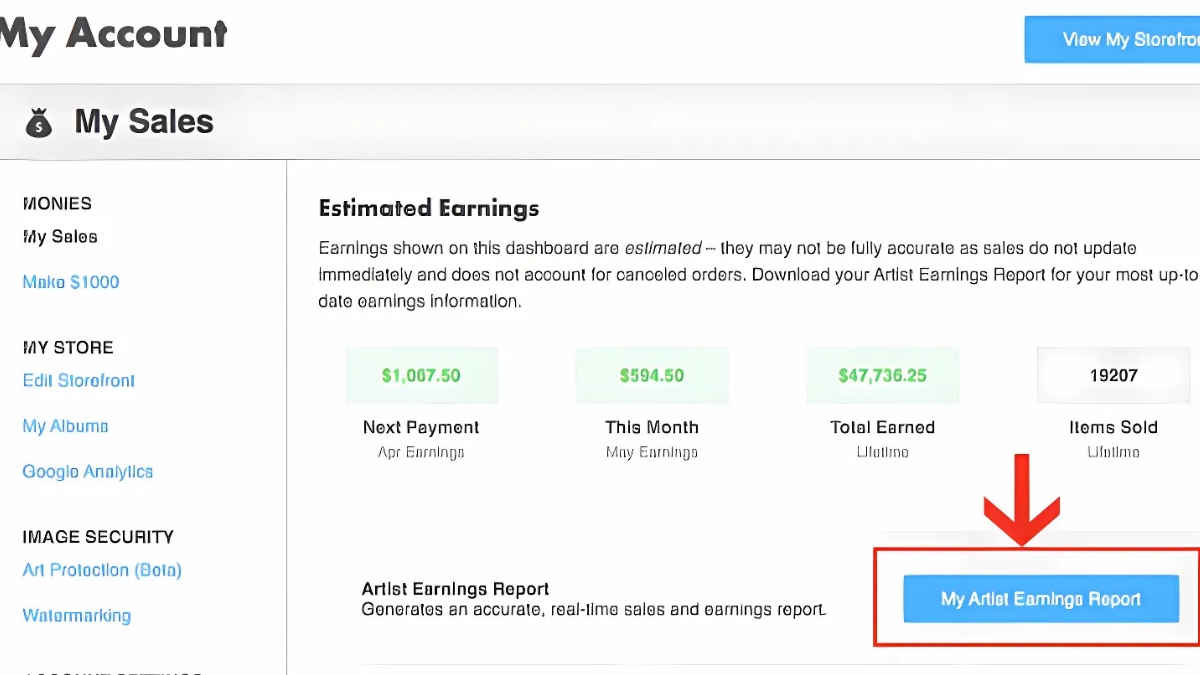
How to Sell Designs on TeePublic in 2025: Complete Guide for Creative
Did you know that the print-on-demand market is projected to reach $39.9 billion by 2030? TeePublic has emerged as one of the leading platforms in this space, offering creators the opportunity to turn their artistic passion into profit. As someone who started their own TeePublic journey, I can tell you that success on this platform goes beyond just uploading great designs – it’s about understanding the marketplace, optimizing your shop, and implementing effective marketing strategies. Ready to transform your creativity into a thriving online business? Let’s dive into everything you need to know!
Getting Started with TeePublic
First things first – you’ll need to head over to TeePublic.com and click that “Sell Your Art” button in the top right corner. Here’s a pro tip that I wish someone had told me: before you even create your account, download their design templates and start preparing your artwork. This way, you won’t feel rushed once you’re in the middle of the setup process.
When you’re ready to sell designs on TeePublic, the account creation process is pretty simple. You’ll need to provide basic info like your email, password, and payment details. But here’s where a lot of people mess up – they rush through the profile setup. Don’t do that! Your profile is like your storefront window. Take time to craft a compelling bio that tells your story and connects with potential buyers. I initially wrote something super generic, and guess what? Crickets. Once I updated it to share my passion for creating nerdy science designs and included my design philosophy, engagement started picking up.
Now, let’s talk about those pesky design requirements. TeePublic has specific file specifications that you absolutely need to follow:
- PNG files with transparent backgrounds
- Minimum resolution of 2400×3200 pixels for t-shirts
- Maximum file size of 15MB
- RGB color mode (I learned this one after trying to upload CMYK files – oops!)
Something that totally caught me off guard was the product variety. When you upload a design, it’s not just for t-shirts. Your artwork can appear on over 70 different products! From hoodies to phone cases to wall art. This is both exciting and challenging because you need to think about how your design will look across different mediums. I’ve found that simpler designs with clean lines tend to work best across multiple products.

The terms of service can be a bit dry (okay, really dry), but they’re super important to understand. The biggest things to know are:
- You must own or have proper licenses for all design elements
- No copyrighted material without permission
- No offensive or hate speech content
- Designs must be original work
One thing that made a huge difference for me was setting up my payout information correctly from the start. TeePublic pays via PayPal or Stripe, and you’ll want this sorted before you start making sales. Trust me, there’s nothing more frustrating than making your first sale and then having to wait extra time for payment because your payment details weren’t properly set up.
Here’s something I discovered by accident – TeePublic has a built-in preview tool that lets you see how your design looks on different colored products. Use it! What looks amazing on a black t-shirt might look terrible on a white one, and you’ll want to adjust accordingly.
Remember, your shop won’t be perfect right away, and that’s okay. Mine certainly wasn’t! Start with a few solid designs, make sure everything’s set up properly, and then you can always tweak and improve as you go. The key is getting started and learning from the process.
Lastly, don’t forget to enable notifications for your account. This way, you’ll know immediately when you make a sale or receive a message from a customer. It helps you stay on top of your shop and provide better customer service, which can lead to repeat buyers.
Creating Designs That Sell
Here’s the thing about research that changed everything for me: you’ve got to become a trend detective. I now spend at least an hour each day checking platforms like Reddit, Twitter, and Instagram to spot emerging trends. One of my biggest wins came from noticing a surge in retro science memes – I created a series of vintage-style chemistry puns that ended up being some of my best sellers.
The key to successful niche research isn’t just following the obvious trends. I use Google Trends to compare different keywords and themes, and I always check what’s trending in specific subreddits related to my target niches. For example, I discovered that plant parents love incorporating scientific names into their merch – something I would’ve never guessed without proper research!
When it comes to actually creating designs that sell on TeePublic, let’s talk technical specifications – because this stuff really matters:
- For t-shirts: 4200×4800 pixels with 300 DPI
- For phone cases: 1748×2698 pixels
- For stickers: 1500×1500 pixels minimum
- Always use RGB color mode (I lost a whole day’s work once by using CMYK!)
But here’s what really makes designs convert – and I learned this through countless trial and error. Your design needs to be instantly readable from 10 feet away. I used to create these intricate, detailed masterpieces that looked amazing up close but were completely lost when printed on a t-shirt. Now I follow what I call the “thumbnail rule” – if it’s not clear in the thumbnail preview, it won’t sell.
Let me share some of my biggest design mistakes so you can avoid them:
- Using too many colors (stick to 3-4 max for best results)
- Making text too small (learned this after customer complaints)
- Creating designs that only work on one product type
- Using gradients that don’t translate well to printing

One game-changing tip I discovered: create mockups of your designs on both light and dark products before uploading. Sometimes a design that looks perfect on black looks terrible on white, and you’ll want to create alternate versions. I use simple editing software to test this – no need for fancy tools.
For text-based designs (which often sell really well), I’ve found that combining two different font styles creates more visual interest. But – and this is crucial – never use more than two fonts in a single design. It gets messy real quick!
Here’s a weird but effective tip: browse TeePublic’s bestsellers in your chosen niche, but don’t look at the designs themselves. Instead, study the composition – the size of elements, the use of space, the contrast. I’m not talking about copying designs (that’s a big no-no), but understanding what makes successful designs work.
The most important lesson I’ve learned about creating designs that sell is this: simplicity wins. Every time I think “maybe I should add just one more element,” I stop myself. Some of my best-selling designs have been the simplest ones – clean, clear, and focused on a single message or image.
Remember that different products need different approaches. A design that looks amazing on a t-shirt might need serious adjustments to work well on a phone case or sticker. I always create variations of my designs optimized for different products – it takes more time upfront but leads to more sales overall.
Lastly, don’t forget about seasonal designs! I keep a calendar of major holidays and events, and start preparing designs at least two months in advance. This kind of planning ahead has helped me catch the seasonal waves of buyers instead of always being a step behind.
Optimizing Your TeePublic Shop
Let’s talk titles first, because this is where I see so many artists stumble. I used to give my designs cute, creative names that meant something to me – but they were terrible for search visibility! Now I approach titles differently. For example, instead of calling a design “Midnight Whiskers,” I’ll use something like “Funny Black Cat Reading Books | Cute Bookworm Pet Lover Gift.” Yes, it’s less poetic, but it helps people actually find your design when they’re searching!
The description field is pure gold for SEO, but here’s the trick – you need to write for both search engines and humans. I structure my descriptions like this:
- First paragraph: Engaging description of the design
- Second paragraph: Who it’s perfect for (gift ideas!)
- Third paragraph: Product recommendations and variations
- Final line: A call to action
Now, let me share something that dramatically changed how I sell designs on TeePublic: strategic tagging. You get 50 tags per design, and you should use every single one! But here’s what I learned the hard way – don’t just spam popular tags. Instead, I organize my tags into these categories:
- Main subject tags (e.g., “black cat,” “reading”)
- Style tags (e.g., “cute,” “kawaii,” “minimalist”)
- Occasion tags (e.g., “birthday gift,” “Christmas”)
- Related interest tags (e.g., “book lover,” “librarian”)
- Product-specific tags (e.g., “funny t-shirt,” “cat sticker”)
Speaking of categories, choosing the right ones is crucial! I once had a design buried in “Miscellaneous” that started selling like crazy after I moved it to a more specific category. TeePublic’s category system is pretty detailed, so take advantage of it. Always choose the most specific subcategory possible – it helps your design reach the right audience.

Pricing was something I really struggled with at first. Here’s what I’ve learned works best:
- Start with the default pricing
- Monitor your competitors in similar niches
- Adjust based on design complexity
- Consider running occasional promotions (but don’t overdo it!)
One thing that really helped my visibility was creating design collections. Instead of having random designs scattered about, I group related designs together. For example, my “Bookish Cats Collection” performs much better than when those same designs were unconnected.
Here’s a pro tip about titles that took me way too long to figure out: include size variations in your title if the design comes in different sizes. Something like “Large Cat Design | Also Available in Small” helps shoppers find exactly what they’re looking for.
Remember to update your shop regularly! I spend about 30 minutes each week reviewing my tags, updating descriptions, and tweaking titles based on what’s performing well. It’s tedious, I know, but it makes a huge difference in visibility and sales.
The last thing I’ll mention – and this was a total game-changer – is using TeePublic’s analytics to inform your optimization strategy. Pay attention to which search terms are bringing people to your designs, and then optimize your other designs using similar patterns. If certain tags or title structures are working well, replicate that success across your shop.
Marketing Your TeePublic Designs
Social media has been an absolute game-changer for my shop. Pinterest turned out to be my secret weapon – something I totally didn’t expect! Here’s what I’ve learned: create Rich Pins that showcase your designs on multiple products, and make sure to include lifestyle shots. I spend about an hour each Sunday scheduling pins for the week, and it’s brought in consistent traffic to my shop.
Instagram requires a different approach entirely. I used to just post my designs and wonder why engagement was low. Now I follow what I call the 80/20 rule:
- 80% behind-the-scenes content, design process videos, and tips
- 20% actual product promotion
- Always use Instagram Stories to share new designs and limited-time offers
- Reels showing design process get WAY more engagement than static posts
One thing that totally transformed my marketing game was starting a TikTok account. I create quick videos showing:
- Design process timelapses
- “Day in the life” content
- Trending audio + design reveals
- Customer styling videos (with permission)
Let’s talk about collaboration – something that scared me at first but has become one of my favorite ways to grow. I reached out to other TeePublic creators in complementary niches (not direct competitors), and we’ve done some amazing cross-promotions. For example, I design cat-themed shirts while my collaboration partner focuses on dog designs – we did a “Pet Lovers Collection” together that performed better than either of us could have done alone.
Email marketing was something I slept on for way too long. Here’s my current strategy:
- Collect emails through my personal website
- Send monthly newsletters with new design previews
- Create exclusive discount codes for subscribers
- Share behind-the-scenes content and design inspiration
- Always include a personal story or update

Content marketing has been huge for driving organic traffic. I started a blog where I share:
- Design tutorials and tips
- Trending t-shirt themes and ideas
- How to style different TeePublic products
- Customer features and success stories
Here’s something that surprised me – Reddit can be an amazing marketing tool if you do it right. The key is to become a genuine member of relevant communities first. I spend time in subreddits related to my design niches, offering help and advice. When I occasionally share my designs (following community rules), they’re usually well-received because I’ve built trust.
One marketing strategy that’s worked really well is creating themed collections aligned with major events or holidays. But here’s the trick – you need to promote these at least 6-8 weeks before the actual event. I learned this after my Halloween designs didn’t start selling until November (face palm).
Discord has been another unexpected win. I joined several design and art communities and created my own server where I share:
- Works in progress
- Design tips and resources
- Exclusive previews
- Limited-time discount codes
The biggest lesson I’ve learned about marketing TeePublic designs is consistency. It’s better to post regularly on two platforms than to try to be everywhere at once. I focus on Pinterest and Instagram as my main channels, with TikTok as my experimental platform for trying new things.
Remember, marketing isn’t just about promoting your designs – it’s about building a community around your work. Share your failures along with your successes. People connect with authenticity, and those connections lead to loyal customers who’ll support your work long-term.
Don’t forget to track everything! I use a simple spreadsheet to monitor which marketing efforts bring in the most sales. This helps me focus my energy on what’s actually working instead of just throwing spaghetti at the wall to see what sticks.
Understanding TeePublic’s Analytics and Earnings
First, let’s talk about the commission structure because it’s not as straightforward as it seems. On a standard t-shirt priced at $20, you’ll earn around $4 per sale. But here’s what I discovered – during promotions, while the selling price drops, your commission only decreases slightly. This means promotional periods can actually lead to higher overall earnings due to increased sales volume! I track my earnings meticulously in a spreadsheet, and some of my best months have been during site-wide sales.
The analytics dashboard became my best friend once I learned how to use it properly. Here’s what I pay attention to:
- Daily and monthly sales trends
- Which products sell best (spoiler: it’s not always t-shirts!)
- Traffic sources
- Search terms that led to sales
- Most popular color variants
Speaking of seasonal trends, let me tell you about my biggest “aha” moment. I noticed that to sell designs on TeePublic successfully during holiday seasons, you need to plan way ahead. Here’s my yearly calendar:
- Valentine’s Day designs: Upload by December
- St. Patrick’s Day: Upload by January
- Mother’s Day/Father’s Day: Upload by March
- Halloween: Upload by August
- Christmas: Upload by September
One thing that surprised me was discovering my “micro-seasons.” These are specific weeks or months when certain niches perform better. For example, my science-themed designs spike during back-to-school season and graduation periods. My gaming designs tend to sell better during major game release months.
Here’s a breakdown of performance metrics I track weekly:
- Conversion rate per design
- Views to sales ratio
- Popular color combinations
- Most successful categories
- Customer feedback and ratings

Let me share some tips for maximizing earnings that I’ve learned through experience:
- Optimize your best-selling designs first
- Create variations of successful designs
- Remove or revamp designs with zero sales after 3 months
- Focus on evergreen niches with seasonal spins
- Always have some designs in promotional periods
The biggest earnings mistake I made early on? Not diversifying my product types. While t-shirts are great, I discovered that some designs sell better on other products:
- Simple icons work great on phone cases
- Detailed artwork sells well on posters
- Text-based designs perform well on mugs
- Cute characters are perfect for stickers
Here’s something interesting about traffic patterns: Monday mornings and Sunday evenings tend to see higher browse-to-buy ratios. I now time my new design uploads to coincide with these peak shopping periods.
Analytics also taught me about color psychology in sales. Designs available in multiple color variations typically sell 3-4 times better than single-color designs. But – and this is important – don’t just enable every color option. Test different combinations and track which ones actually sell.
One of my favorite tricks is using the analytics to identify “sleeper hits” – designs that get consistent but modest sales over long periods. These often end up earning more than viral designs that spike and fade quickly.
Remember to check your analytics regularly, but don’t obsess over daily numbers. I review mine weekly and do a deep dive monthly. This helps me spot trends without getting caught up in day-to-day fluctuations.
Finally, don’t forget about the power of bundles and collections. When I group related designs together, I typically see a 20-30% increase in per-design sales. The analytics clearly show that customers who buy one design from a collection often return to buy others from the same series.
Legal Considerations and Copyright
Let me tell you about the legal side of things – an area where I learned some tough lessons when I started to sell designs on TeePublic. Trust me, understanding the legal stuff isn’t just boring paperwork – it’s absolutely crucial for protecting yourself and your business!
I remember the first time I got excited about a pop culture design idea and almost uploaded it without checking the licensing requirements. Thank goodness I did my research first! When you sell designs on TeePublic, you need to be absolutely certain that you have the rights to every element in your designs. Here’s what I’ve learned about intellectual property rights the hard way:
Original Work:
- Document your design process (I keep all my sketches and drafts)
- Save your working files with layers intact
- Keep dated versions of your work
- Screenshot any reference images you legally use
- Note down inspiration sources
Let’s talk about what you can and can’t use:
✅ Your original artwork
✅ Fonts you’ve purchased with commercial licenses
✅ Public domain elements (but verify they’re really public domain!)
❌ Copyrighted characters
❌ Sports team logos
❌ Company logos
❌ Screenshots from movies or TV shows
One thing that shocked me was learning about parody law. Just changing a few elements of a copyrighted character isn’t enough to qualify as parody – it needs to be commenting on or criticizing the original work in some way. I’ve seen so many shops get shut down because they thought “inspired by” meant “okay to use.”

Here’s my process for protecting my own designs:
- Register copyright for your most valuable designs
- Keep detailed records of creation dates
- Use watermarks on preview images
- Document when and where you publish designs
- Save all original files in multiple locations
If you spot someone copying your work (it happened to me!), here’s what to do:
- Document everything with screenshots
- Gather your proof of original creation
- Contact TeePublic’s support team
- File a DMCA takedown notice if necessary
- Consider registering trademarks for successful design series
Speaking of trademarks, here’s something important: just because you can’t find something trademarked doesn’t mean it isn’t! Some phrases and symbols have common law trademark protection without being registered. When in doubt, do extra research or consult a lawyer.
One practice that’s helped me stay safe is creating a “rights management spreadsheet.” For each design, I track:
- Creation date
- Reference sources
- Font licenses
- Image licenses
- Registration info
- Publication dates
If you’re using licensed content (like fonts or stock elements), keep a folder with:
- License agreements
- Purchase receipts
- Usage rights documentation
- Terms of service
- Commercial use verification
Remember, different countries have different copyright laws. Since TeePublic sells globally, it’s best to err on the side of caution and follow the strictest guidelines. I learned this after realizing something that was public domain in one country was still under copyright in another!
Finally, don’t forget about model releases if you use photos of people in your designs. Even silhouettes of recognizable people need proper permission. I once had to pull a design because I didn’t realize the reference photo I used (which I took!) needed a model release from the person in it.
Success on TeePublic isn’t just about artistic talent – it’s about combining creativity with smart business strategies. By following this comprehensive guide, you’re now equipped with the knowledge to start and grow your TeePublic shop. Remember, consistency and adaptability are key in the print-on-demand market. Start implementing these strategies today, and don’t forget to regularly analyze your performance to refine your approach. Your creative journey to passive income starts now!





